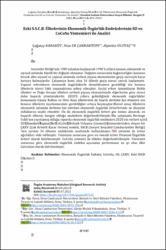Eski S.S.C.B. Ülkelerinin Ekonomik Özgürlük Endekslerinin SD ve CoCoSo Yöntemleri ile Analizi
Abstract
Sovyetler Birliği’nde 1989 yılından başlayarak 1990’lı yıllara uzanan, ekonomik ve
siyasal anlamda büyük bir değişim olmuştur. Değişim sonucunda bağımsızlığını kazanan
birçok ülke siyasal ve yapısal anlamda serbest piyasa ekonomisine geçiş süreciyle karşı
karşıya kalmışlardır. Çalışmaya konu olan 14 ülkede geçiş süreci sancılı başlamıştır.
Yapısal reformların ekonomik özgürlüklerle desteklenmesi gerekliliği söz konusu
ülkelerin süreci faklı yaşamalarına sebep olmuştur. Geçişi erken tamamlayan Baltık
ülkeleri ve Doğu Avrupa ülkeleri serbest piyasa ekonomisinde diğerlerine göre süreci
daha başarılı yönetmişlerdir. 2020’li yıllara gelindiğinde ekonomik özgürlükler
konusunda Güney Kafkas ve Orta Asya ülkelerinin de büyük ilerleme kat etmeleri söz
konusu ülkelerin incelenmesinin gerekliliğini ortaya koymuştur. Genel amaç ülkelerin
ekonomik anlamda ilerleme kat ederken ekonomik özgürlük kriterlerinde ne düzeyde
olduklarını analiz etmektir. On iki ekonomik özgürlük kriteri göz önüne alınarak, en
başarılı ülkenin hangisi olduğu analizlerle değerlendirilmiştir. Bu çalışmada Heritage
Vakfı’nın yayınlamış olduğu raporda ekonomik özgürlük endeksleri 2020 yılı verileri için
SD (Standart Sapma) ve CoCoSo (Birleşik Uzlaşma Çözümü) yöntemlerinden oluşan bir
ÇKKV (Çok Kriterli Karar Verme) modeli, SSCB (Sovyet Sosyalist Cumhuriyetler Birliği)
’den ayrılan 14 ülkenin endeksinin analizinde kullanılmıştır. SD yöntemi ile kriter
ağırlıkları elde edilmiştir. Yöntemin sonucuna göre en önemli kriter Finansal Özgürlük
kriteri olarak belirlenmiştir. CoCoSo yöntemi ile ülkeler değerlendirilmiştir. Yöntemin
sonucuna göre ekonomik özgürlük endeksi açısından performansı en iyi olan ülke
Gürcistan olarak belirlenmiştir. There has been a great economic and political change in the Soviet Union starting
from 1989 and extending to the 1990s. Many countries that gained their independence as
a result of the change faced the process of transition to a free market economy in political
and structural terms. The transition process in the 14 countries that are the subject of the
study has started with pain. The necessity of supporting structural reforms with economic
freedoms caused the countries in question to experience the process differently. Baltic
countries and Eastern European countries, which completed the transition early,
managed the process more successfully than others in the free market economy. When it
comes to the 2020s, the South Caucasus and Central Asian countries have made great
progress in terms of economic freedoms, revealing the necessity of examining these
countries. The general aim is to analyze which level of economic freedom criteria of
countries while making progress in economic terms. Considering the twelve economic
freedom criteria, which country is the most successful has been evaluated through
analysis. In this study, in the report published by the Heritage Foundation, an MCDM
(Multi Criteria Decision Making) model consisting of SD (Standard Deviation) and CoCoSo
(Combined Compromise Solution) methods for the 2020 data of economic freedom
indices was used in the analysis of the index of 14 countries that left the USSR (Union of
Soviet Socialist Republics). Criteria weights were obtained by the SD method. According
to the results of the method, the most important criterion was determined as the Financial
Freedom criterion. Countries were evaluated with the CoCoSo method. According to the
results of the method, the country with the best performance in terms of economic
freedom index was determined as Georgia.
Volume
10Issue
1The following license files are associated with this item:


















